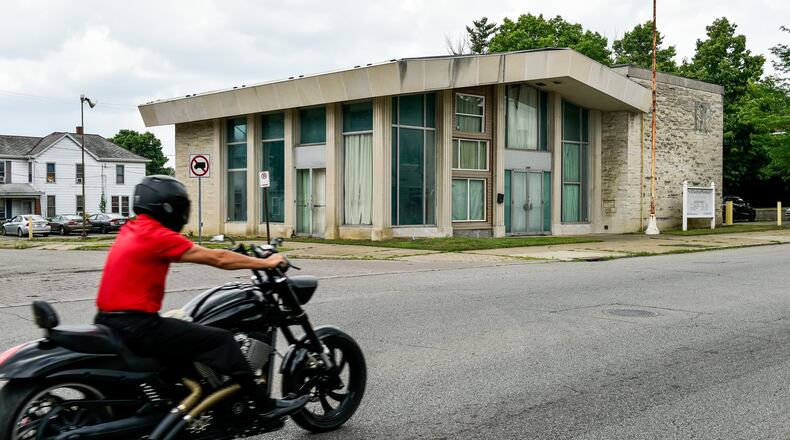Neighborhood leader Frank Downie and city Planning Director Liz Hayden expressed delight with the students’ work, saying it greatly exceeded their expectations. The students, mostly seniors, had volunteered their services to the city.
Their 39-page report, "Pleasant Avenue Revitalization Strategy, Lindenwald, Hamilton, OH," looks at Pleasant Avenue, the spine of the neighborhood with clusters of businesses along the route. The students, overseen by associate geography professor David Prytherch, recommended focusing on four buildings to energize the neighborhood and business district.
A look at the buildings and their suggested future uses:
- The former Shuler & Benninghofen Woolen Mills, built in 1893, led to people moving into Lindenwald, the workers and the wealthy owners not only of the mill but other factories and manufacturers that located there. The facility now is mostly vacant, with small areas that house two businesses. The building now is on the market, the students reported. They suggested a development similar to "The Plant" in Chicago's Bask of the Yards neighborhood. The Plant has arsenal bakeries, shops and local food production, and draws outsiders to the to the neighborhood. The Mill could include such specialty stores as bakeries, bike shops, restaurants, and micro-manufacturing centers, with possibly some occupancy by Miami University's Hamilton campus, the students wrote.
- The Grand, which originally opened as the Linden Theatre in 1940 and was open nearly 50 years, is now in disrepair. The students suggested a beautified theater with an in-house cafe that sells beer, wine and quality food that moviegoers can eat at their seats. The students envisioned the theater as helping turn Lindenwald's business corridor into an entertainment hub, serving students from Miami Hamilton and luring a new generation of visitors to the neighborhood. The cafe also could be open to people not watching films, plays, guest speakers or comedians there.
- The New Linden Lanes, which opened in 1939, operated for 72 years, but now is vacant and is up for sale. The building, located adjacent to the mill, can become a functional alley again, with stores along its street-facing facade. The students also recommended converting Williams Avenue, which separates the bowling alley from the mill, into a pedestrian-only street during community events.
- The former community church is "a prime spot for reuse," the students wrote. "Advantages of the current structure include an open space, mid-century modern building and large parking lot." The students envisioned the building as a community center and neighborhood gathering space. It could host live music, festivals and other events.
Lindenwald, first settled in 1852, had its growth accelerated by the Cincinnati, Hamilton and Dayton railroad. The village of Lindenwald was annexed in 1908 by Hamilton.
The students noted, “In 1955 with the formation of Fairfield at the southern border, any new expansion of Lindenwald came to a halt and the neighborhood began its decline,” with industries starting to shut down or move away.
With large retailers appearing in Fairfield, Lindenwald’s smaller local businesses were not able to compete. Some 8.2 percent of Lindenwald buildings are vacant, the students reported.
Their report expresses hope that the creation of South Hamilton Crossing. Students also propose to slow traffic and make Pleasant Avenue more pedestrian friendly, with more attractive sidewalks, can help the area rebound.
Other suggestions included energizing dull building exterior walls with colorful murals and creating community gathering spaces on under-used properties and along some sidewalks.
City Manager Joshua Smith in late 2016 announced plans to focus on business corridors of Pleasant Avenue in Lindenwald, and Central Avenue in the city’s Second Ward when properties in the Main Street area were leased and rents were being paid to the non-profit development organization called the CORE (Consortium for Ongoing Reinvestment Efforts) Fund.
The city last year made available $3.45 million to the non-profit Community Improvement Corporation that was loaned to the CORE Fund. When that $3.45 million was recouped, it could become seed money to finance improvements along Central and Pleasant, similar to what has been done in the High Street and Main Street areas.
RELATED: With 1,000 new jobs on way, Hamilton targeting rebirth
When the Miami class presented its report to Lindenwald’s neighborhood association, known as PROTOCOL (People Reaching Out To Others; Celebrate Our Lindenwald), “everyone at the meeting was in awe,” Downie said.
“If the goals of this strategy are ever met Lindenwald could return to the moniker people placed on it years ago; Lindenwald is a City unto itself,” Downie said. “Instead of our residents traveling into Fairfield and northern Cincinnati for goods and services, we could shop here while residents of other municipalities to our south and east would feel compelled to make the trip to Lindenwald.”
The only thing standing in the way is funding, Downie added, noting the city has been committed to helping Pleasant and Central avenues. Unfortunately, he said, “The return on investments along our High/Main corridor has been slower than expected, so improvements along Ohio 127 have been set back.”
The Miami students hope the opening of the South Hamilton Crossing highway project, which will link Ohio 4 directly to Lindenwald, will spur more business activity in the neighborhood.
Some of the concepts can be easily accomplished, such as the possibility of StreetSpark murals along the corridor next year, Hayden said.
“The thing is, they did such a nice job,” Hayden said. “This would be a planning document that we would come together with as we get ready to develop a strategy.”
About the Author




